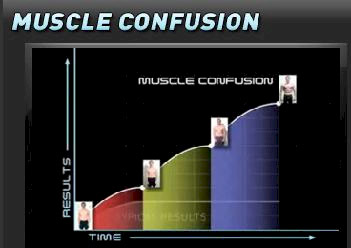MUSCLE CONFUSION WORKOUTS: REAL SCIENCE OR A MYTH?

“You need to constantly switch up your workouts in order to shock your muscles into growth!”
The idea that you need to constantly change up your exercises, rep ranges and workout structure in order to “shock” or “confuse” your muscles into new growth is a fairly common piece of bodybuilding advice you’ll hear.
The idea behind this is that after following a certain weight training prescription for a set period of time, the muscles will adapt, plateau and stop responding.
Because of this widespread idea, many lifters end up haphazardly switching from routine to routine for fear that their muscle growth will slow down if they fail to do so.
They’ll switch up their exercises, use different rep ranges, change up the order of their lifts and train using different muscle groupings in the hopes that the change will somehow confuse the body and force it to continue growing bigger and stronger.

The reality? This is complete and total nonsense.
There are a ton of well-accepted bodybuilding “truths” out there that are not based on anything but imagination, and this one is no different.
Your muscles do not have a mind of their own. They are not sitting there analyzing the movements that you’re performing, which tool you’re using to perform it (whether it be a barbell, dumbbell or cable), how many times you’re doing it or in what manner you’re executing it.
Your muscles simply perform the movement patterns that you carry out in the gym and then respond to the overall load and intensity. They adapt to stress, plain and simple.
If you regularly perform barbell rows and you switch to performing dumbbell rows, your muscles are not thinking to themselves, “Oh no! He’s using dumbbells now! We’d better pack on some extra muscle mass this time!”
As long as you train with sufficient intensity and focus on progressive overload from week to week, your muscles will continue to grow larger and stronger as long as proper rest, nutrition and injury prevention are taken into account.
If it were true that the body only responds to certain exercises for a set period of time, then how could powerlifters go through a lifetime of performing squats, deadlifts and bench presses while seeing continual progress from start to finish?
Plateaus do exist, but they are completely within your control and have nothing to do with your muscles somehow failing to react based on the repetitive use of the same routine.
Instead of haphazardly changing your training style, take a look at other potential factors that could be causing your gains to stagnate. This could include things like insufficient calorie intake, inadequate training intensity, overtraining, injuries/joint weakness and improper rest just to name a few.
Is it possible to change from one routine to another and see a difference in results?
Of course, but this has nothing to do with the muscles being “confused” or “shocked” by the change.
Different types of training programs and exercises will simply yield different types of results.
A program that uses low to moderate reps and focuses on hypertrophy is going to produce a different result than an endurance program that uses high reps or a strength building program that uses very low reps.
Obviously switching from one style to another (or landing somewhere in between) will produce a different physical response from the body.
Is it okay to switch up your routine every couple months for a change?

If you want to change things for mental variety, to accommodate an injury or to focus on a different goal, then go ahead. Just don’t make the mistake of thinking that switching from tricep pressdowns to dips will “shock” your triceps into new growth or that training your shoulders with your legs instead of your chest will somehow “confuse” your body into packing more muscle size onto your shoulders.
As long as you train hard and consistently, make adjustments to your intensity and volume, and stay on top of your nutrition, it’s perfectly possible to use the exact same routine for years on end and see continued gains in muscle size and strength.
If you found this article helpful, make sure to sign up for your FREE custom fitness plan below...




